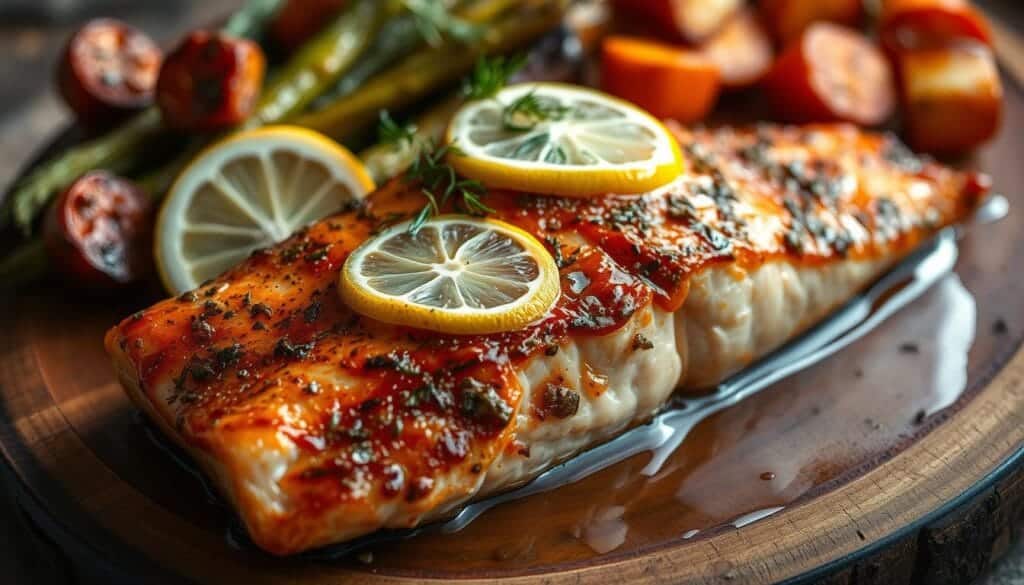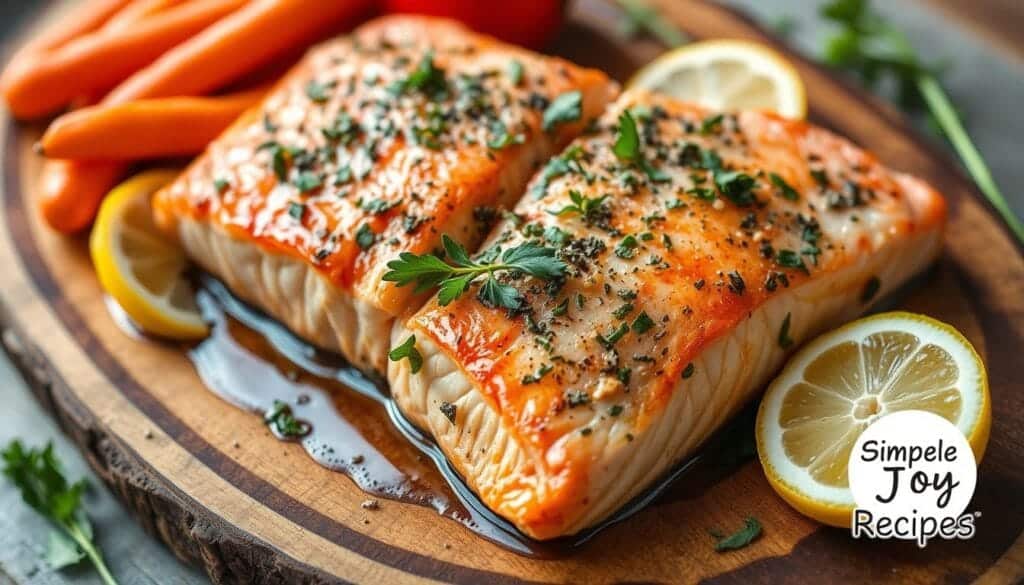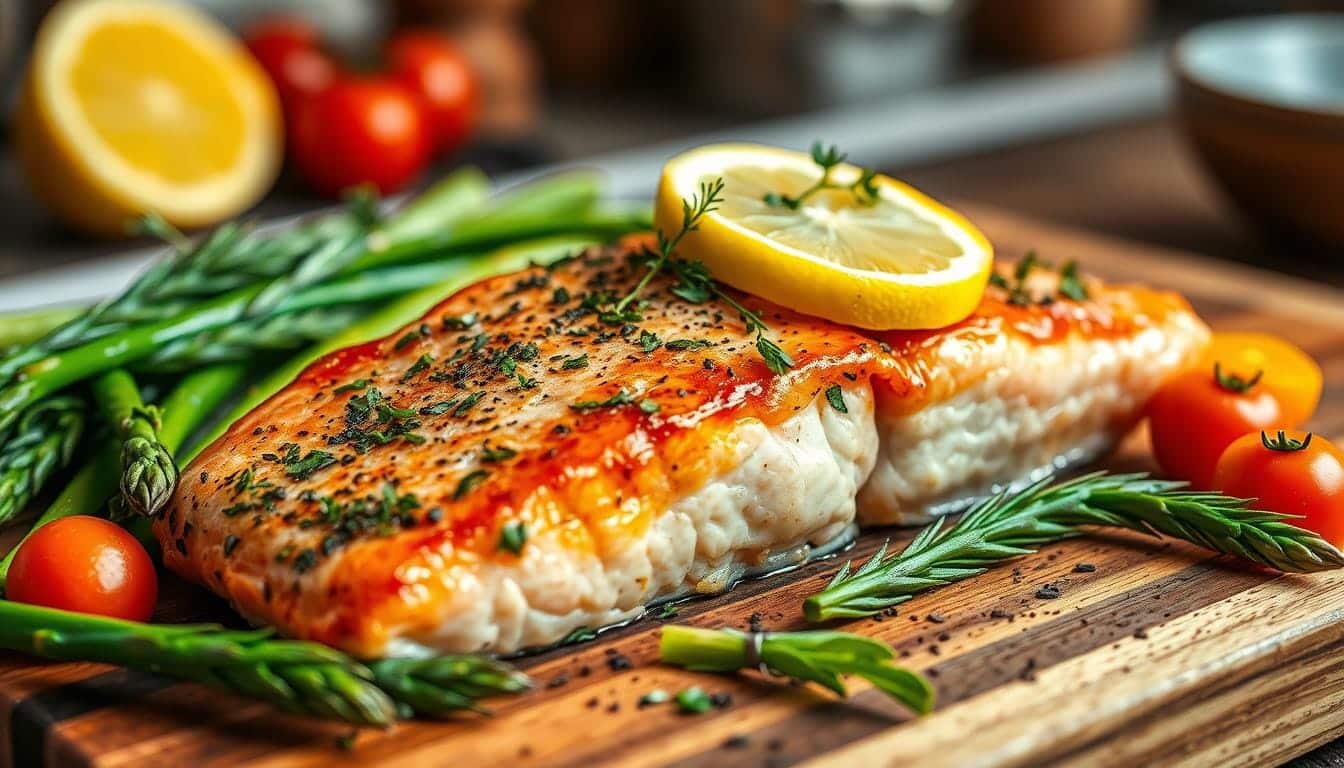I’ve spent hours in the kitchen trying out different ways to cook salmon. I’ve tried everything from searing to poaching. My love for this fish has grown with each new technique.
This guide will show you the best ways to cook salmon. You’ll learn about baking, grilling, pan-searing, and poaching. Whether you’re new to cooking or a pro, you’ll find tips to make your salmon dishes amazing.
Salmon is not just tasty; it’s also packed with nutrients like omega-3 fatty acids. Learning to cook salmon well means you can enjoy it in many ways. It becomes a key part of your healthy meals.
Table of Contents
Unlock the Secrets of Perfectly Cooked Salmon
It’s easier than you think to make delicious, restaurant-quality salmon at home. The secret is to learn the basic cooking techniques. These techniques help bring out the best in this nutritious and tasty fish.
Mastering Salmon Cooking Techniques
There are many ways to cook salmon, like baked salmon, grilled salmon, pan-seared salmon, and poached salmon. Each method has its own special way of making salmon taste amazing. Knowing how to use each technique will help you cook salmon that always tastes great.
- Baked salmon: It’s tender and flaky with a sweet, caramelized outside.
- Grilled salmon: It gets a smoky flavor and beautiful grill marks.
- Pan-seared salmon: It has a crispy, golden crust and a juicy inside.
- Poached salmon: It’s soft and silky, keeping the fish’s natural taste.
Common Mistakes to Avoid When Cooking Salmon
Avoid these common mistakes to make sure your salmon is always top-notch:
- Don’t overcook the salmon, or it will be dry and tough.
- Make sure to season the fish well to avoid a bland taste.
- Let the salmon rest before serving to keep the juices in.
- Choose the right cooking method for the salmon’s thickness and cut.
By learning the key techniques and avoiding these mistakes, you’ll make perfectly cooked salmon. It will be delicious and look great too.

Baked Salmon: Simplicity at Its Best
When it comes to cooking salmon, baked salmon stands out for its simplicity and elegance. This method lets the fish’s natural flavors shine, making a healthy and tasty meal. It’s perfect for those who want a delicious dinner without much fuss.
To get perfectly cooked baked salmon, know the right temperature and timing. Preheat your oven to about 400°F (200°C). Let the salmon fillets bake for 12 to 15 minutes, depending on their thickness. This way, the fish will be tender and flaky, ready to be enjoyed.
Want to add more flavor to your baked salmon? Try different seasonings and marinades. Baked salmon goes well with salt, pepper, and lemon juice. Or, you can use a marinade with herbs, spices, and a bit of sweetness.

Baked salmon is also very versatile. You can change it up to fit your taste or your family’s needs. Pair it with roasted veggies, fresh salads, or fluffy rice for a complete meal that will wow everyone.
Whether you’re an experienced cook or just starting out, learning to make baked salmon is worth it. It’s easy to do and offers great taste and health benefits, making it a favorite among seafood lovers.
Grilled Salmon: Adding a Smoky Twist
Take your salmon to the next level with grilled salmon. It brings a smoky, charred taste that’s perfect for outdoor cooking. This twist will wow your guests and boost your cooking skills.
Tips for Grilling Salmon to Perfection
Learning to grill salmon is a fun challenge. Here are some tips to keep your salmon moist, flavorful, and just right:
- Heat your grill to medium-high, about 400-450°F (200-230°C). This is the best temperature for searing.
- Wipe the grill grates with oil to stop the salmon from sticking.
- Dry the salmon fillets with paper towels and season them well with your favorite spices or marinade.
- Put the salmon on the grill, skin-side down first. Let it sear for 4-6 minutes, until it’s easy to remove.
- Flip the salmon and grill for another 4-6 minutes. This depends on how thick the fillets are. They should flake easily with a fork.
- Don’t overcook the salmon. It can get dry and tough quickly. The perfect internal temperature is 145°F (63°C).
By using these tips, you’ll get delicious, smoky grilled salmon. It will make your taste buds happy and impress your guests.
“Grilling salmon adds a unique, outdoor-inspired flavor that can truly impress your guests and elevate your culinary skills.”
Pan-Seared Salmon: Quick and Flavorful
Pan-searing is a quick and tasty way to cook salmon. It lets you make a meal like a restaurant’s at home. You get a crispy outside and a juicy inside. It’s perfect for when you’re in a hurry or want a tasty salmon dish.
To make great pan-seared salmon, follow a few steps. First, dry and season the salmon with salt and pepper. This helps the crust form. Then, heat a skillet over medium-high and add oil like avocado or grapeseed.
When the oil starts shimmering, put the salmon in the pan, skin-side down. Don’t move the salmon for a few minutes. This helps the skin get crispy and golden. After the skin is done, flip the salmon and cook for another 2-3 minutes until it’s fully cooked.
Pan-seared salmon is very versatile. Try different seasonings like lemon-pepper or garlic and herb. Serve it with roasted veggies, a salad, or your favorite sides for a full meal.
“The key to perfectly pan-seared salmon is patience. Let the fish develop a nice crust before flipping, and you’ll be rewarded with a mouthwatering dish.”
With a bit of practice, you can make amazing pan-seared salmon. It’s great for big gatherings or a quick dinner. This method will soon be a favorite in your kitchen.
Poached Salmon: Tender and Healthy
For salmon lovers, poaching is a big win. It keeps the poached salmon tender and full of flavor. Learn how to make poached salmon and take your seafood dishes to the next level.
Poaching Salmon: A Gentle Cooking Method
Poaching is a great way to cook poached salmon. It cooks the fish in a flavorful liquid, making it tender. This method is also healthy, as it keeps the fish’s nutrients and omega-3s intact.
- Start with fresh, high-quality poached salmon fillets.
- Bring a large, shallow pan or skillet filled with a poaching liquid (such as water, broth, or a blend of wine and herbs) to a gentle simmer.
- Carefully add the salmon fillets, ensuring they are fully submerged in the liquid.
- Poach the salmon for 10-15 minutes, or until it flakes easily with a fork.
- Remove the poached salmon from the liquid and serve immediately, or chill for later use in salads, sandwiches, or other dishes.
The secret to perfect poached salmon is a gentle simmer. Don’t let the liquid boil, as it can make the fish tough. With a bit of practice, you’ll get the hang of it and enjoy delicious results.
“Poaching salmon is a simple yet elegant way to preserve the fish’s natural goodness and vibrant flavor.”
Best Way to Cook Salmon: Flavor-Packed Marinades
Marinades can make your salmon dishes amazing. They add a mix of tastes, from tangy to sweet. Learn how to make a marinade that suits your taste and cooking style.
Marinades bring out the best in salmon. They add flavor and make the fish tender. You can choose from bold or subtle marinades, depending on your taste.
Crafting the Perfect Salmon Marinade
Think about what flavor you want. Do you like tangy or earthy tastes? Try different ingredients like:
- Fresh herbs like dill, basil, or cilantro
- Acidic elements like lemon juice, lime juice, or vinegar
- Aromatic spices like garlic, ginger, or peppercorns
- Sweet notes from honey, maple syrup, or brown sugar
- Savory components like soy sauce, Dijon mustard, or Worcestershire sauce
Whisk your ingredients together. Let your salmon soak for at least 30 minutes before cooking. Longer marinating means deeper flavors.
Finding the right marinade balance is key. Experiment and adjust until it tastes just right to you.
“The true essence of a great salmon dish lies in the marinade. It’s the foundation upon which all other flavors are built.”
Let your creativity flow and explore salmon marinades. They can take your salmon dishes to new heights of flavorful excellence.
Elevate Your Salmon with Delicious Seasonings
Unlock the full potential of your salmon by trying different seasonings and spice blends. From classic lemon-pepper to bold and exotic flavors, you can enhance the natural taste of salmon. This will help you create mouthwatering dishes that impress your guests.
Exploring Salmon Seasoning Combinations
Seasoning your salmon can make it go from good to great. Here are some delicious seasoning ideas to try:
- Lemon-Pepper: A timeless classic that brightens up the salmon’s flavor with a zesty punch.
- Garlic and Herb: A fragrant blend that complements the fish’s richness and pairs well with roasted vegetables.
- Cajun Spice: For a bold and spicy twist, this Creole-inspired seasoning adds a kick of heat and depth of flavor.
- Teriyaki: A sweet and savory Japanese-inspired marinade that caramelizes beautifully on the salmon.
- Dill and Mustard: A refreshing combination that showcases the salmon’s natural essence.
| Seasoning | Flavor Profile | Cooking Method |
|---|---|---|
| Lemon-Pepper | Bright, Zesty | Baked, Grilled |
| Garlic and Herb | Aromatic, Savory | Baked, Pan-Seared |
| Cajun Spice | Spicy, Flavorful | Grilled, Blackened |
| Teriyaki | Sweet, Tangy | Baked, Broiled |
| Dill and Mustard | Fresh, Tangy | Poached, Baked |
Try these salmon seasonings to find your favorite flavors and cooking methods. Elevate your salmon dishes to new heights of deliciousness!
Salmon Nutrition: A Powerhouse of Omega-3s
Salmon is a nutritional superstar, full of vitamins, minerals, and healthy fats. It’s famous for its omega-3 fatty acids. These are key for heart, brain, and overall health.
Salmon is packed with omega-3s, like EPA and DHA. These fats are known to fight inflammation, lower blood pressure, and boost brain and heart health.
| Nutrient | Amount per 3.5 oz (100g) of Salmon |
|---|---|
| Protein | 22g |
| Omega-3s (EPA and DHA) | 2.2g |
| Vitamin B12 | 4.8mcg |
| Selenium | 38.8mcg |
| Vitamin D | 526IU |
Salmon is also rich in protein, vitamins B12 and D, and selenium. Adding salmon to your diet can boost your health. These nutrients are vital for staying healthy.
To get the most from salmon, choose gentle cooking methods. Baking, grilling, or poaching are best. Avoid overcooking to keep nutrients and flavor intact.
Transform Leftovers into Stunning Salmon Dishes
Don’t let leftover salmon go to waste! There are many ways to make new dishes from extra portions. You can make salmon cakes, salads, chowders, and pasta. These are just a few ideas to turn leftover salmon into tasty meals.
Creative Ways to Use Leftover Salmon
Salmon is great for many recipes. You can make salmon cakes or patties. Just add breadcrumbs, herbs, and mayonnaise for a crispy dish.
Try adding salmon to a fresh salad. Mix it with greens, avocado, and a zesty dressing. Or, make a creamy salmon chowder or add it to pasta like alfredo or lemon-garlic linguine.
Be creative with leftover salmon. Use your imagination in the kitchen. Turn extra portions into something delicious and satisfying.
FAQ
What is the best way to cook salmon?
Cooking salmon can be done in many ways, each with its own charm. You can bake, grill, pan-sear, or poach it. Each method brings out different flavors and textures, making your salmon dish unique.
What are some healthy cooking methods for salmon?
For a healthy salmon dish, try baking, grilling, or poaching. These methods keep the fish’s nutrients and omega-3s intact. They avoid adding too much fat or oil.
How can I make flavorful marinades for my salmon?
To make tasty marinades, mix citrus juices, herbs, spices, and sauces. Let the salmon soak in these flavors. This way, the fish absorbs the tastes, making it delicious and well-seasoned.
What are some common mistakes to avoid when cooking salmon?
Avoid overcooking salmon to prevent it from becoming dry. Also, don’t forget to season or marinate it well. Handling the fish gently is key to keep it intact while cooking.
How can I use leftover salmon in creative ways?
Use leftover salmon in many ways. You can make salmon cakes, add it to salads or pasta, or use it in soups. Being creative with leftovers helps reduce waste and keeps your meals interesting.
What are the health benefits of eating salmon?
Salmon is packed with nutrients, including omega-3s, which are good for your heart and brain. It’s also rich in protein, vitamins, and minerals. This makes salmon a great choice for a healthy diet.

